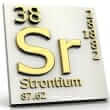Background
- Strontium is a silvery gray element that was first discovered in the early 1800s. It is a soft, easily worked metal that resembles calcium. Because of this similarity, strontium can replace calcium in certain processes in the body. Strontium may promote extra calcium uptake into bones.
- Strontium has sixteen forms: twelve radioactive and four nonradioactive. Strontium-88 is the most common form, making up 83% of natural strontium. Strontium-90 is a radioactive form that earned public attention for being a dangerous byproduct released from nuclear weapons testing in the 1950s. Strontium-89 chloride is another radioactive form used to reduce pain in people with cancer and is the active ingredient in the U.S. Food and Drug Administration (FDA)-approved drug Metastron®.
- In the United States, strontium salts (carbonate, chloride, citrate, gluconate, sulfate, etc.) are available as dietary supplements. According to secondary sources, the most common form of strontium found in dietary supplements is strontium chloride. Strontium chloride, as well as strontium acetate, may be found in dental products like Sensodyne®, a toothpaste used to reduce pain caused by teeth sensitivity.
- In Europe, strontium ranelate is a prescription drug used for osteoporosis. It is marketed under the trade names Protos®, Protelos®, Osseor®, Bivalos®, and Protaxos®. According to previous and ongoing research, strontium ranelate may prevent bone loss, increase bone strength, and reduce fractures in postmenopausal women. It may also benefit people with osteoarthritis.
- Strontium nitrate has been studied for skin irritation and inflammation caused by allergic reactions to cosmetics, personal care products, and drugs, and during occupational exposure. However, large, well-designed trials are needed before a conclusion can be made.
- According to experts, taking calcium and strontium at the same time may reduce strontium absorption. Strontium ranelate should not be used in people with kidney problems. Preliminary studies suggest that strontium may increase the risk of artery blockages.
References
- Benson, L., Cordell, L., Vincent, K., et al. Ancient maize from Chacoan great houses: where was it grown? Proc.Natl.Acad.Sci.U.S.A 10-28-2003;100(22):13111-13115. View Abstract
- Cohen-Solal, M. E., Augry, F., Mauras, Y., et al. Fluoride and strontium accumulation in bone does not correlate with osteoid tissue in dialysis patients. Nephrol.Dial.Transplant. 2002;17(3):449-454. View Abstract
- D'Haese, P. C., Schrooten, I., Goodman, W. G., et al. Increased bone strontium levels in hemodialysis patients with osteomalacia. Kidney Int. 2000;57(3):1107-1114. View Abstract
- D'Haese, P. C., Couttenye, M. M., Lamberts, L. V., et al. Aluminum, iron, lead, cadmium, copper, zinc, chromium, magnesium, strontium, and calcium content in bone of end-stage renal failure patients. Clin.Chem. 1999;45(9):1548-1556. View Abstract
- English, N. B., Betancourt, J. L., Dean, J. S., et al. Strontium isotopes reveal distant sources of architectural timber in Chaco Canyon, New Mexico. Proc.Natl.Acad.Sci.U.S.A 10-9-2001;98(21):11891-11896. View Abstract
- Jaakkola, A., Heikkonen, J., Tommila, P., et al. Strontium plaque brachytherapy for exudative age-related macular degeneration: three-year results of a randomized study. Ophthalmology 2005;112(4):567-573. View Abstract
- Ketchel, B. P., Heid, C. A., Wood, G. L., et al. Three-dimensional color holographic display. Appl.Opt. 10-10-1999;38(29):6159-6166. View Abstract
- Meunier, P. J., Roux, C., Seeman, E., et al. The effects of strontium ranelate on the risk of vertebral fracture in women with postmenopausal osteoporosis. N.Engl.J.Med. 1-29-2004;350(5):459-468. View Abstract
- Naess, I. A., Christiansen, S. C., Romundstad, P., et al. Incidence and mortality of venous thrombosis: a population-based study. J.Thromb.Haemost. 2007;5(4):692-699. View Abstract
- Nakamatsu, K., Nishimura, Y., Kanamori, S., et al. Randomized clinical trial of postoperative strontium-90 radiation therapy for pterygia: treatment using 30 Gy/3 fractions vs. 40 Gy/4 fractions. Strahlenther.Onkol. 2011;187(7):401-405. View Abstract
- Oger, E. Incidence of venous thromboembolism: a community-based study in Western France. EPI-GETBP Study Group. Groupe d'Etude de la Thrombose de Bretagne Occidentale. Thromb.Haemost. 2000;83(5):657-660. View Abstract
- Reginster, J. Y., Seeman, E., De Vernejoul, M. C., et al. Strontium ranelate reduces the risk of nonvertebral fractures in postmenopausal women with osteoporosis: Treatment of Peripheral Osteoporosis (TROPOS) study. J.Clin.Endocrinol.Metab 2005;90(5):2816-2822. View Abstract
- Rizzo, J. A., Medeiros, D., Silva, A. R., et al. Benzalkonium chloride and nasal mucociliary clearance: a randomized, placebo-controlled, crossover, double-blind trial. Am.J.Rhinol. 2006;20(3):243-247. View Abstract
- Schrooten, I., Elseviers, M. M., Lamberts, L. V., et al. Increased serum strontium levels in dialysis patients: an epidemiological survey. Kidney Int. 1999;56(5):1886-1892. View Abstract
- Silverstein, M. D., Heit, J. A., Mohr, D. N., et al. Trends in the incidence of deep vein thrombosis and pulmonary embolism: a 25-year population-based study. Arch.Intern.Med. 3-23-1998;158(6):585-593. View Abstract







